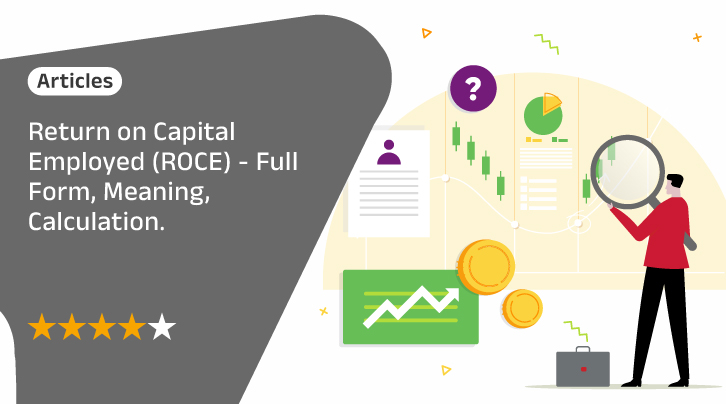-
Our Products
Our FundsFocus Funds
-
Self Care
Self-ServiceFind InformationWays To TransactPartner Solutions
-
Downloads
- Learnings
- About Us
-
More
-
Shareholders
-
Shareholders
-
Updates
-
-
SIP Calculators
- Back
-
Shareholders
Return on Capital Employed (ROCE)

Feb 14, 2024
5 min
4 Rating
ROCE is an important financial metric that offers insights into how efficiently a company is utilizing its capital. Read this post to know more.
When investors analyze a company's fundamentals to decide whether it is a good investment, they closely look over various financial metrics. These commonly include EPS (Earnings Per Share), P/E (Price-to-Earnings) Ratio, P/B (Price-to-Book) Ratio, and D/E (Debt-to-Equity) Ratio.
However, many of them overlook ROCE. The metric sheds light on a company's capital efficiency and profitability, helping determine how successfully the company is using its capital to generate profits. Here are some of the most important things every investor should know about ROCE-
What is Return on Capital Employed (ROCE)?
Return on Capital Employed or ROCE is a financial ratio that measures the efficiency and profitability of a company in terms of its total capital employed.
The capital employed is a combination of equity and debt, representing the total funds invested in the business for generating profits.
Also Read – Gross Profit Ratio
What is the ROCE Formula?
The formula used to calculate ROCE is as follows-
ROCE= EBIT/Capital Employed x 100
Here, EBIT, or Earnings Before Interest and Tax, is the company's operating income, indicating the earnings it generates from the operations before deducting interest payments and taxes.
Capital employed, on the other hand, is the company's total assets minus the current liabilities. So, Capital Employed= Total Assets-Current Liabilities.
By dividing EBIT by capital employed and multiplying the number by 100, we can find the ROCE of a company in percentage.
How to Calculate ROCE?
Here is an example to help you understand what is ROCE and how it is used for analyzing and comparing companies-
Example
According to the recent annual report of Company A, its operating income in 2022 is ₹50 crores. The company has total assets worth ₹200 crores and current liabilities of ₹70 crores. So, the ROCE of the company for 2022 will be calculated as follows-
ROCE= EBIT/Capital Employed x 100
=₹50 crores/( Total Assets-Current Liabilities) x 100
=₹50 crores/(₹200 crores-₹70 crores) x 100
=₹50 crores/₹130 crores x 100
=38.46%
So, Company A has an ROCE of 38.46% for 2022.
Now, another company, Company B, has an EBIT of ₹100 crores. With an EBIT of ₹100 crores, Company B might appear a better investment than Company A which has an EBIT of ₹50 crores. However, the ROCE calculation can reveal some valuable insights.
Company B has assets worth ₹500 crores and current liabilities of ₹150 crores. So, the Capital Employed by Company B will be ₹350 crores and its ROCE will be as follows-
ROCE= EBIT/Capital Employed x 100
=₹100 crores/₹350 crores x 100
=28.57%
So, with regard to ROCE, Company A is a better investment as it has an ROCE of 38.46% while Company B has an ROCE of 28.57%.
What is the Importance of ROCE?
Here are some of the reasons why investors lay emphasis on ROCE-
-
ROCE is a key indicator of how well a company is utilizing its capital. A higher ROCE suggests that the company is efficient at deploying the available resources.
-
ROCE is commonly used to compare the performance of companies in the same industry.
-
It can also be used for tracking the financial efficiency of a company over the years. A company with a rising or stable ROCE can be considered a good investment.
What are the Limitations of ROCE?
While ROCE offers valuable insights into the capital usage of the companies, it also has a few drawbacks such as-
-
As companies from different sectors utilize capital differently, ROCE is not an effective metric to compare the performance of companies from different sectors.
-
ROCE is calculated based on the historical financial performance of a company. As a result, it does not accurately represent the present circumstances or future possibilities.
-
Companies also often have significant unused cash reserves. As ROCE only considers the employed capital, such cash-rich companies can also have a lower ROCE.
ROCE VS ROE - What Should You Use?
ROE or Return on Equity is another popular financial metric used to analyze profit-making companies. It is calculated by dividing the net income of a company by shareholders’ equity. In other words, it measures how well a company uses shareholder equity to generate profits.
As ROCE considers equity and debt, it offers a more comprehensive view of how well a company is utilizing its total capital.
Mastering ROCE to Refine Your Stock Selection Strategy
Return on Capital Employed (ROCE) is a crucial financial metric that offers valuable insights into a company’s profitability, efficiency, and overall financial health. When used along with other key financial measures, ROCE can help investors make better investment decisions.
If you’re new to the stock market and finding it difficult to understand these key metrics, ensure you consult with a professional investment advisor. Alternatively, you can also consider investing in mutual funds according to your investment goals and risk appetite.
Mutual Fund investments are subject to market risks, read all scheme related documents carefully.





 1800-270-7000
1800-270-7000



